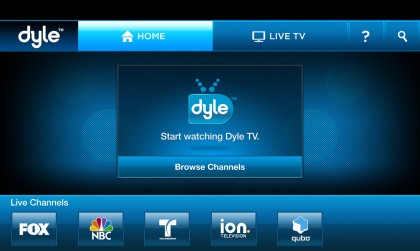
The mobile TV service Dyle was originally scheduled to go live last year, but in a follow-up to its showcase at CES in January, Dyle’s Mobile Content Venture backers want us to know the service hasn’t lost its momentum. Dyle has added 17 more stations to its line-up and is planning for a 2012 launch. Rounding out the 70+ channels already on its roster, Dyle will now include new stations from Belo, Cox Media Group, Fox, Gannett Broadcasting, ION, Post-Newsweek, Meredith, Raycom, CBS Television and LIN Media.
Dyle is showing off its wares this week at the National Association of Broadcasters (NAB) show. In addition to announcing an expanded channel list, the company is also reportedly demonstrating its broadcast service on a new LG Android phone. At launch, Dyle says it will cover 35 markets and reach more than 55% of U.S. homes.
So what’s the real deal with Dyle? In short, the venture is designed to pick up where FLO TV left off. If all goes according to plan, Dyle will broadcast live news, sports and entertainment over the air to mobile devices. OTA means no carrier intervention and no data caps. However, it also means availability is subject to markets where the broadcast signal is strong enough. And we’re talking live video, no on-demand. Dyle also says it will launch as a free service, but it doesn’t promise to stay that way.
It’s unclear whether there’s a market for OTA mobile television. FLO TV couldn’t make a go of it, but on the other hand, consumers are a lot more sensitive to data caps now that fewer carriers offer unlimited plans. And Dyle has already shown that users can retrofit some existing mobile gear in order to access the new service. Add a Belkin dongle with earbuds, and you should be able to turn your iPad into a Dyle TV receiver.
From an industry perspective, it will be interesting to watch how successful broadcasters can be with the OTA service because of what the experiment means to the ongoing wireless spectrum debate. Broadcasters believe they should hold on to some of the spectrum they regained after the digital TV transition specifically for services like Dyle. Wireless carriers would rather use it to sell more wireless data plans.
While interesting (much like FloTV) I don’t see the market for this:
– people don’t normally watch movies or TV on their mobile devices. It’s nice to see that it works but, day to day, they don’t do this.
– If you wanted to do this you could just go with a SlingBox and avoid monthly fees.
– We’ve had portable TVs for decades. About 5″ is the smallest people would use and that was for something like camping or RVs (even now I’d think RVs would just use a portable DirecTV setup). All of those Casio portable TVs were never used except on Christmas day. You never saw one out in the open with someone watching it.
Portable TVs are good at football games. And Slingboxes-to-mobiles at those events are even better. :) I don’t think it’ll take off, either. But I do like watching video on my smartphone… but it’s via Sling, Netflix, HBO GO, etc.
I use a Hava HD Platinum (the newer model is called Vulkano)And it works great for providing me TV content from one of my TiVos when not at home. Certainly a much better solution than what mobile TV is. Especially since I have access to all the channels available from my cable provider. Not just a handful of local stations.
Agreed, BradB –
While on the surface it seems like there would be a market, particularly for people like me that travel frequently and carry multiple mobile devices, I think there is a limit to how much viewing most people will engage in on a small screen. Personally, a few minutes of sports highlights or maybe a short podcast are about all I can stand. Full length TV shows or movies…no thanks.
I’ve got one of those 7″ portable TVs, with built-in rechargeable battery.
Nice, but the built-in antenna only good for about 20 miles.
Hey, simply thought I would certainly drop by and say just what a remarkable site you have.
With regards to streaming boxes if anyone is taking
into consideration buying one … I have a Roku player and might absolutelyrecommend one.
The quantity of channels the Roku delivers is outrageous, definitely defeats that of the
Apple TV and other streaming box competitors. Sorry,
my English is not that good, I hope you can understand.